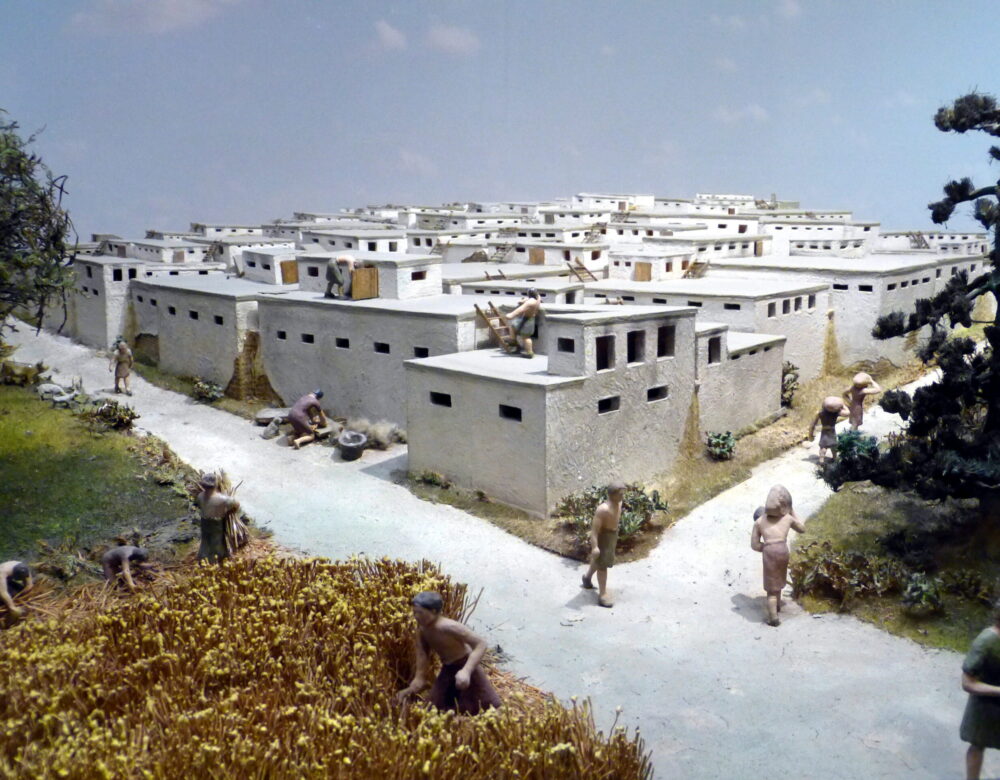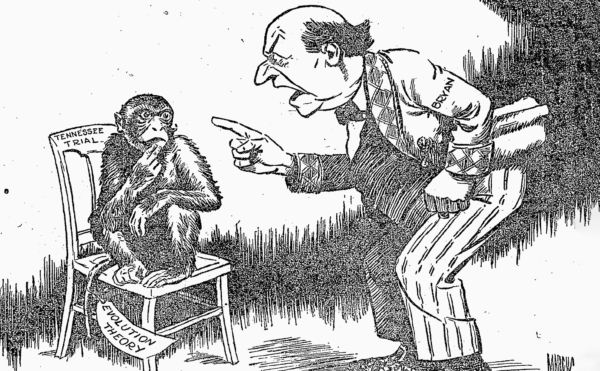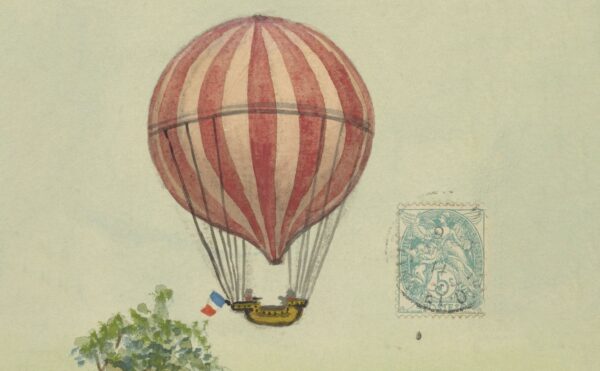A chance encounter on a train, incredibly valuable (and potentially stolen) ancient treasures, mixed-up addresses—the story of archaeologist James Mellaart and the scandal that undermined his credibility may be stranger than fiction.
About The Disappearing Spoon
The Science History Institute has teamed up with New York Times best-selling author Sam Kean to bring a second history of science podcast to our listeners. The Disappearing Spoon tells little-known stories from our scientific past—from the shocking way the smallpox vaccine was transported around the world to why we don’t have a birth control pill for men. These topsy-turvy science tales, some of which have never made it into history books, are surprisingly powerful and insightful.
Credits
Host: Sam Kean
Senior Producer: Mariel Carr
Producer: Rigoberto Hernandez
Associate Producer: Sarah Kaplan
Audio Engineer: Jonathan Pfeffer
Transcript
Her name was Anna. And as soon as she entered the train car, James Mellaart was bewitched.
It wasn’t because she was beautiful, although she was. It was the bracelet on her wrist, gleaming gold. His trained eye instantly recognized it as a treasure from the days of ancient Troy.
It was spring 1958, and the 33-year-old Mellaart was traveling through western Turkey. He was a plump man with thick glasses, a no-name archaeologist from England. The discoveries that would make him famous were still years away. But he burned with ambition.
His obsession in life was Turkey. He had moved to Turkey years earlier, and had married a Turkish archaeologist. He was especially obsessed with a region of central Turkey called Anatolia, or Asia Minor. Mellaart wanted to prove that Anatolia had a history every bit as glorious as Rome or Greece. So as soon as he saw the Anatolian bracelet on the arm of the woman in the train, he was transfixed. He screwed up his courage and introduced himself.
Her name was Anna Papastrati. She spoke English well. She told him she lived in Izmir, a city on the Turkish coast. As Mellaart peppered her with questions, she revealed that she had a whole horde of similar treasures at her house. Did Mellaart want to see them?
Of course he did. But, Mellaart had no place to stay in Izmir. Anna, though, offered to put him up for the night at her house.
However excited, Mellaart hesitated. His wife would be furious about him sleeping at a strange woman’s home. But his lust for archaeology got the better of him. Besides, it was just one night. He said yes.
He had no idea that this one night would haunt him for the rest of his life.
In Izmir, Mellaart and Anna took the ferry to her home. But before they examined the artifacts, Anna insisted on cooking him dinner. They dined overlooking the water, under candlelight, with a bottle of wine. Afterward, Anna wanted to linger at the table and chat, but Mellaart insisted on seeing the artifacts.
They did not disappoint. There were gold earrings, ivory combs, jeweled daggers, necklaces with turquoise and amber. Mellaart recognized them as belonging to the so-called Yortan culture, which thrived thousands of years ago near the fabled city of Troy.
Anna said the treasures came from a place called Dorak, a town south of Istanbul. They’d been unearthed during a war in the 1920s. But she dodged Mellaart’s questions about how she’d come to obtain them.
Mellaart did not press her. And he soon forgot such questions amid his excitement over the treasures. He spent the whole next day studying them. When night fell, Anna encouraged him to stay another night. So he did. The same thing happened the next day and the next. In all he spent a week in Anna’s home, fawning over the treasures while she fawned over him.
Mellaart made detailed drawings of the artifacts, but Anna forbid him from taking photographs. Instead, she promised to mail him some photos. This seemed odd, but Mellaart agreed and gave her his address. And upon finally leaving her home, he slyly noted her address—217 Kazim Dirik Street.
Then Mellaart went back home to his wife, and waited for Anna’s letter. A whole month passed, then another. Summer arrived and drifted into fall. But still no letter from Anna. Mellaart began to fret like a jilted lover. Why hadn’t she written yet? Did he do something wrong? He finally could not take it anymore, and wrote to her instead. No answer came.
Meanwhile, Mellaart was busy doing other archaeology. In fact, that November, he made a discovery that would catapult him to worldwide fame.
It involved a site called Çatalhöyük in south-central Turkey. It’s a 9000-year-old city, perhaps the first true city in history. And beyond its incredible age, other things made the place special, too.
People in Çatalhöyük lived in mudbrick homes that stood just inches apart. There were no streets, no parks, no open spaces. People got from place to place by walking across each other’s roofs. The houses didn’t have doors, either. People entered and exited their homes on ladders through skylights. Çatalhöyük was a sky city.
The insides of the homes were special, too. People painted spectacular murals on the walls—of bulls, vultures, leopards. They crafted figurines of animals and goddesses as well.
Most fascinating of all, the people of Çatalhöyük buried their dead inside their homes—and did so right in the dirt beneath their beds. Every night you would tuck in to sleep with the skeletons of grandma and grandpa and your crazy uncle just inches beneath your head.
When Mellaart discovered Çatalhöyük in 1958, the city was buried beneath a giant mound of dirt sixty feet tall, with weeds covering it. But even during preliminary digs, he could tell Çatalhöyük was special—the murals, the skeletons in the bedroom, the people walking on the roofs. Who wouldn’t be enchanted?
Even while making these spectacular discoveries, however, Mellaart’s heart was still elsewhere—on the Dorak treasures. In between digs at Çatalhöyük, he spent many empty months pining over the treasures and writing Anna letters that she never answered.
Until one day, finally, she wrote back.
Mellaart tore open the letter, his heart pounding. But it was disappointingly brief. And it contained none of the promised photographs. Anna finished by saying, “You were always more interested in these old things than in me.” It was signed “Love, Anna.”
Mellaart never heard from Anna again. Baffled and heartbroken, he finally gave up writing her. Then he published a short article about the treasures in a British magazine, along with his drawings.
And he thought that would be that, but the article caused a big stir among archaeologists. What amazing treasures! Unfortunately, it also landed Mellaart in a world of trouble.
You see, the Turkish government was quite sensitive about its ancient artifacts, for good reason. Centuries of looting and smuggling had robbed Turkey of much of its cultural history. There were strict laws there about reporting all archaeological finds. But no one had reported the Dorak artifacts. They were undocumented, and government officials were furious to find out about them in a magazine. Who was this Anna anyway? How did she get her hands on such treasures?
The officials demanded that Mellaart turn Anna in. Having no other choice, he gave them her address—217 Kazim Dirik Street in Izmir.
But upon arriving in Izmir, the officials noticed something strange. 217 Kazim Dirik Street was a shopping center. No one lived there. There were no houses or apartments nearby, either. Something was not adding up.
And that’s when Turkish officials began to suspect that James Mellaart was not telling them everything he knew.
When they could not find Anna, Turkish officials turned their investigation—and anger—toward James Mellaart. They accused him of working with smugglers. They figured the point of the magazine article was to hype the Dorak treasures and drive up their price. Then, after the smugglers sold the goods, Mellaart would take a cut of the profits.
When confronted with these charges, Mellaart denied everything. In fact, privately, he was starting to suspect that Anna was the one working with smugglers. Had it really been a coincidence that he’d met her on the train? And would she really be wearing ancient treasures on vacation? Perhaps she was a plant. Perhaps she had deliberately worn the bracelet to grab his attention. Then, after he confirmed the goods as authentic, she had disappeared and handed them to smugglers to sell.
Mellaart confessed his suspicions to the Turkish authorities. But they did not buy his theory. It seemed too convenient. Plus, after digging around a bit, they caught Mellaart in a few lies about Anna.
One lie involved when he had met Anna. Sometimes he said 1952, sometimes 1958. Mellaart protested that he was just trying to avoid troubles with his wife. He hadn’t been married in 1952, and he sometimes gave that earlier date to avoid questions about him shacking up with another woman.
However understandable, the lies undermined Mellaart’s credibility. The Turkish newspapers were soon buzzing with stories about the fat greedy foreigner who was stealing Turkey’s heritage.
Now, all this while, Mellaart continued to dig at Çatalhöyük, the ancient city where people walked across the roofs and buried their family members beneath their beds. In fact, his discoveries there won him worldwide renown.
But as a foreigner, Mellaart needed permits to dig in Turkey. And as the Dorak scandal grew, Turkish officials began threatening those permits. In 1964, they denied the permits completely, meaning Mellaart couldn’t excavate that year.
Mellaart was furious. He threw an absolute fit. By calling in some favors, he managed to win his permits back in 1965. But it was a short-lived victory. Because another scandal soon erupted.
For the excavation at Çatalhöyük, Mellaart had hired diggers from local villages in Turkey. Whenever the workers found something special—like a leopard statue, or a goddess figurine—they told Mellaart. Mellaart then reported every item to the Turkish government—or at least every item he knew about.
One day in mid-summer 1965, a government official visited an antique shop twenty miles from Çatalhöyük. On the shelves there, she was shocked to see three figurines from Çatalhöyük for sale. All illegally.
She seized the figurines and demanded that the shopkeeper tell her where he got them. He claimed that diggers from the site had just walked in one day and sold them. So the official grabbed the shopkeeper by the ear, and dragged him to the dig site to confront Mellaart.
Upon seeing the figurines, Mellaart’s heart sank. They were undoubtedly from Çatalhöyük. But he denied all knowledge of wrongdoing. He led the shopkeeper over to his workers. The shopkeep quickly fingered four of them as the culprits.
A heated argument erupted, with accusations flying back and forth. The workers denied everything. And they were so angry about being called thieves that they quit on the spot—as did all the other workers.
Mellaart now faced disaster. Although innocent, his name would be sullied by this scandal, since it took place on his dig site. Equally bad, without diggers, work on the site pretty much stopped for the year.
And it soon became clear that the digging would not resume anytime soon. Mellaart tried to apply for more permits the next year. The government denied them—and told Mellaart he’d be lucky to ever work in Turkey again.
Meanwhile, there was a twist with the saga of the Dorak treasures. The British tabloids had been following the Mellaart scandal avidly. And in 1966, two reporters went down to Turkey to dig up some dirt. What they found shocked them.
They visited Izmir, the city where Anna lived. They began searching for her at 217 Kazim Dirik street. To their bafflement, they realized that there were two streets with that name in the same city. One was indeed a shopping center. But the other was a residence.
They raced right over. Had they found Anna at last?
That’s when the story swerved again. The reporters learned that, a few years earlier, the government had renamed several local roads. The government was trying to bring some order to the city’s chaotic street plan. And while they were at it, officials renumbered all the houses as well.
The bottom line was, between the renaming and renumbering—as well as the general turnover of people moving in and out of the neighborhood—no one quite remembered where the old 217 Kazim Dirik Street was. The journalists searched and searched, but never found a trace of Anna.
The development left Mellaart in agony. It was partial vindication—proof, he said, that the Turkish government had botched its original investigation. But it fell short of the exoneration he needed. Without Anna, he could not prove his innocence. As a result, the Turkish government retained the upper hand.
The government soon banned Mellaart from Çatalhöyük for life. Mellaart had discovered Çatalhöyük—one of the most important archaeological sites in history. But he never set eyes on it again.
The Turkish government did not stop there, either. After banning Mellaart, officials erected a huge fence around Çatalhöyük. And no one else dug there for the next thirty years. Unfortunately, they also left the site exposed to the elements. Before long, rain and heat destroyed several priceless murals. And mudbrick homes that had lasted nine thousand years crumbled into dust in months. All because of James Mellaart had gotten into a spat with the Turkish government.
In the end, the Dorak treasures never turned up. Like Anna, they vanished. And overall it’s probably impossible to say what really happened in the Dorak affair.
The simplest explanation is that Mellaart just made the whole thing up. Or perhaps the treasures did exist, but Mellaart changed key details about them or about Anna, perhaps to protect her.
For his part, Mellaart went to his death in 2012 claiming he had been framed. And many archaeologists who knew him still believe he’s innocent.
But other clues say perhaps not.
As of now, the only tangible evidence that Anna existed is the letter she sent to Mellaart saying she loved him. But there are some fishy details about that letter.
For one thing, in the letter’s address line, Anna misspelled “Kazim Dirik” Street. Which seems a bit suspicious, considering she lived there. And that’s not all.
Anna dated the letter as 10-dash-18, October 18th. But instead of the numeral 1, there’s a capital I in the 10 and the 18. Read literally, it says I-zero and I-eight. Which is weird. Who beyond the Romans would use an I for a 1 like that?
Well, James Mellaart’s wife did. For whatever reason, when his wife wrote letters to people, she usually typed a capital I instead of a 1. And is it really a coincidence that Anna supposedly did as well?
More likely, Mellaart’s wife was in on the hoax. How ironic if, after all that smoke from Mellaart about his wife getting angry over Anna, his wife was maybe helping him perpetrate a fraud the whole time.
Even worse for Mellaart, after his death, his family found something disturbing. His office was full of fake, supposedly ancient artifacts from Anatolia. It’s not clear why Mellaart was making them.
Perhaps to sell. Or, perhaps he was forging them for scholarly reasons. Again, he was obsessed with proving that Anatolia had a glorious past. So perhaps he invented fraudulent evidence to support that theory. Regardless, this discovery further undermined an already teetering reputation.
And the worst part is, it was all so unnecessary. The incident with Anna supposedly took place in spring 1958. And later that same year, Mellaart discovered Çatalhöyük—which proved beyond all doubt that Anatolia did have a glorious past, a past every bit as grand as Rome or Greece.
But because of his alleged misdeeds, Mellaart was banned from exploring that past. In the end, his invented treasures cost him the real ones.




